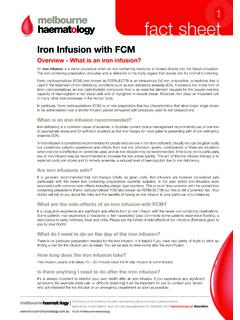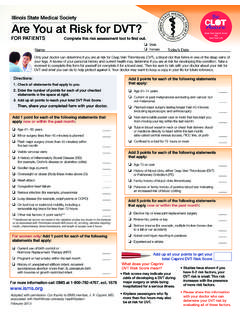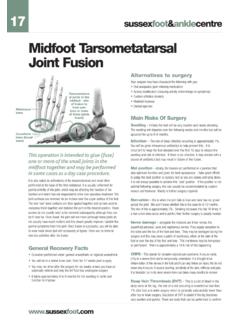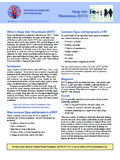Transcription of Deep Vein Thrombosis - DVT | Blood Clots | …
1 2012 Melbourne Haematology1fact sheetClinical and laboratory trained haematologists providing comprehensive laboratory investigation and clinical management for patients with haematological venous Thrombosis or DVT refers to a Blood clot that occurs in the ( deep ) veins of the body. What are veins and what is a clot ( Thrombosis )?Veins are Blood vessels that carry Blood back to the heart from the muscles and other body organs (compared to arteries which carry Blood from the heart to the muscles). A clot generally occurs in a vein when there is a slowing down or a blockage to the Blood flow in the veins. A clot will develop when Blood stops flowing normally. The deep veins are a network of large veins that drain Blood from the tissues and muscles back to the heart and lungs. Why have I developed a DVT?There are a number of risk factors why people may develop a DVT. These include. Hospitalisation for a medical illness or surgery Recent major surgery or injury Previous history of DVT Personal or family history of a clotting disorder History of active cancer and concurrent cancer therapy Pregnancy and first 6 weeks after delivery Smoking Hormone replacement therapy or high dose combined oral contraceptive pill Being overweight or obese Prolonged sitting (greater than 6 to 8 hours)Sometimes people develop Blood Clots for no apparent reason.
2 These are often called spontaneous are the symptoms or signs of a DVT?Pain and swelling are usually the main symptoms of a DVT. Sometimes the area around a Blood clot can feel warmer than the surrounding are Blood Clots detected?The diagnosis of DVT based on symptoms alone can be difficult. A venous doppler ultrasound is frequently ordered to confirm the diagnosis. Ultrasound machines use sound waves to detect Blood flow in veins and arteries. A clot can be detected because of the decreased Blood flow in the veins. Ultrasound is painless and does not have any major side effects. Sometimes Blood tests are also used to help in the detection of Blood Clots . What are the main problems with DVT s?There are three main problems with a Blood clot in the deep veins. 1. The first problem is that Blood Clots in the deep veins can be painful and cause lots of swelling. A number of medications can be used to treat the pain and it is important to limit the swelling as much as possible.
3 The best way to decrease swelling is to use tight (graduated compression) stockings. These stockings are very tight at the ankle and less tight in the calf and so they help the Blood return uphill to the heart. These stockings are very tight at the ankle and less tight in the calf and so they help the Blood return uphill to the heart. It is also important to keep your leg up (elevated) as much as possible. (See the related information sheet on Graduated Compression Stockings). deep Vein Thrombosis (DVT) 2012 Melbourne Haematology2fact sheetClinical and laboratory trained haematologists providing comprehensive laboratory investigation and clinical management for patients with haematological Vein Thrombosis - DVTFURTHER QUESTIONS?The information presented in this fact sheet is intended as a general guide only. Patients should seek further advice and information about DVT and their individual condition from their treating haematologist or additional information about Blood disorders and their treatment, or to contact one of our specialist haematologists, visit the Melbourne Haematology website: last updated: January 8, 20132.
4 The second problem is that Blood Clots can sometimes break off and travel to the lungs and seriously affect lung and heart functions. This condition is known as pulmonary embolus (PE). PE can be life-threatening and may result in The third problem of Blood Clots is that once a vein is blocked with a clot, other veins will need to take over the role of the blocked vein. Sometimes this can cause long term swelling of the leg which can be uncomfortable and lead to skin changes including ulcers (this is called Post Thrombotic Syndrome or PTS). (See the related information sheet on Post Thrombotic is the treatment for DVT?Most treatment for DVT can occur without hospitalisation this may be necessary however if there are extensive Clots or there is a suspicion of pulmonary embolus. Blood thinning (anticoagulation) is the main treatment for DVT and PE to prevent further Blood Clots . They can be in the form of an injection ( Clexane) or tablets ( warfarin).In very serious cases, a medication to dissolve the Blood clot can be used.)
5 There is a significant risk of bleeding with this medication and you should discuss this carefully with your doctor. This will require close monitoring in a can I do to prevent further DVT?Maintaining a healthy lifestyle is important to reduce the risk of further DVT. This includes: quit smoking maintain healthy body weight regular exercise maintain adequate hydration and legs movement, especially during long distance travel selective use of compression stockings and low dose anticoagulant drugs in high-risk hospitalised patients. Resources used in producing this patient information Vascular Disease Foundation ( ) Better Health Channel ( )








